wipers TOYOTA CAMRY HYBRID 2018 Owners Manual (in English)
[x] Cancel search | Manufacturer: TOYOTA, Model Year: 2018, Model line: CAMRY HYBRID, Model: TOYOTA CAMRY HYBRID 2018Pages: 596, PDF Size: 10.25 MB
Page 3 of 596

3
1
9 7 6
5
4
3
2
8
4-1. Before drivingDriving the vehicle ............. 190
Cargo and luggage............ 198
Vehicle load limits ............. 201
Trailer towing..................... 202
Dinghy towing.................... 203
4-2. Driving procedures Power (ignition) switch ...... 204
EV drive mode................... 210
Hybrid transmission........... 213
Turn signal lever................ 219
Parking brake .................... 220
Brake Hold ........................ 224
4-3. Operating the lights and wipers
Headlight switch ................ 227
Automatic High Beam ....... 230
Windshield wipers and washer ............................ 234
4-4. Refueling Opening the fuel tank cap .................................. 238 4-5. Using the driving
support systems
Toyota Safety Sense P ...... 242
PCS (Pre-Collision System)..... 249
LDA (Lane Departure Alert with steering
control) ............................ 260
Dynamic radar cruise control with full-speed
range ............................... 270
Driving assist systems ....... 283
BSM (Blind Spot Monitor)......... 290
• BSM function ................. 294
• RCTA function ............... 296
Rear Camera Detection Function........................... 300
Intuitive parking assist ....... 304
Intelligent Clearance Sonar (ICS) ..................... 312
Driving mode select switches........................... 333
4-6. Driving tips Hybrid vehicle driving tips ................................... 335
Winter driving tips .............. 338
4Driving
Page 15 of 596
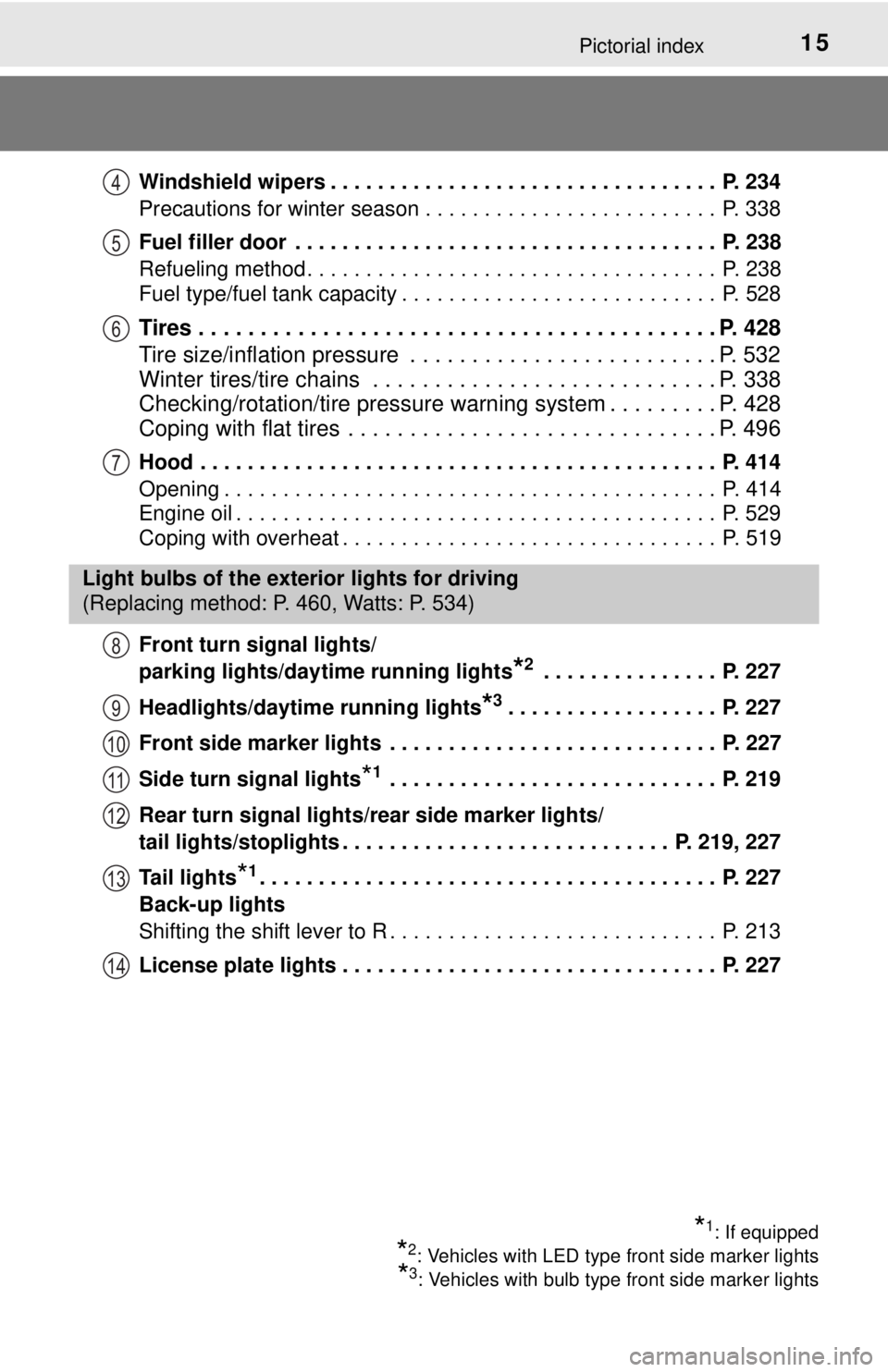
15Pictorial index
Windshield wipers . . . . . . . . . . . . . . . . . . . . . . . . . . . . . . . . . P. 234
Precautions for winter season . . . . . . . . . . . . . . . . . . . . . . . . . P. 338
Fuel filler door . . . . . . . . . . . . . . . . . . . . . . . . . . . . . . . . . . . . P. 238
Refueling method . . . . . . . . . . . . . . . . . . . . . . . . . . . . . . . . . . . P. 238
Fuel type/fuel tank capacity . . . . . . . . . . . . . . . . . . . . . . . . . . . P. 528
Tires . . . . . . . . . . . . . . . . . . . . . . . . . . . . . . . . . . . . . . . . . . P. 428
Tire size/inflation pressure . . . . . . . . . . . . . . . . . . . . . . . . . P. 532
Winter tires/tire chains . . . . . . . . . . . . . . . . . . . . . . . . . . . . P. 338
Checking/rotation/tire pressure warning system . . . . . . . . . P. 428
Coping with flat tires . . . . . . . . . . . . . . . . . . . . . . . . . . . . . . P. 496
Hood . . . . . . . . . . . . . . . . . . . . . . . . . . . . . . . . . . . . . . . . . . . . P. 414
Opening . . . . . . . . . . . . . . . . . . . . . . . . . . . . . . . . . . . . . . . . . . P. 414
Engine oil . . . . . . . . . . . . . . . . . . . . . . . . . . . . . . . . . . . . . . . . . P. 529
Coping with overheat . . . . . . . . . . . . . . . . . . . . . . . . . . . . . . . . P. 519
Front turn signal lights/
parking lights/daytime running lights
*2 . . . . . . . . . . . . . . . P. 227
Headlights/daytime running lights
*3. . . . . . . . . . . . . . . . . . P. 227
Front side marker lights . . . . . . . . . . . . . . . . . . . . . . . . . . . . P. 227
Side turn signal lights
*1 . . . . . . . . . . . . . . . . . . . . . . . . . . . . P. 219
Rear turn signal lights/r ear side marker lights/
tail lights/stoplights . . . . . . . . . . . . . . . . . . . . . . . . . . . . P. 219, 227
Tail lights
*1. . . . . . . . . . . . . . . . . . . . . . . . . . . . . . . . . . . . . . . P. 227
Back-up lights
Shifting the shift lever to R . . . . . . . . . . . . . . . . . . . . . . . . . . . . P. 213
License plate lights . . . . . . . . . . . . . . . . . . . . . . . . . . . . . . . . P. 227
4
5
6
7
Light bulbs of the exterior lights for driving
(Replacing method: P. 460, Watts: P. 534)
*1: If equipped
*2: Vehicles with LED type front side marker lights
*3: Vehicles with bulb type front side marker lights
8
9
10
11
12
13
14
Page 189 of 596

189
4Driving
4-1. Before drivingDriving the vehicle ............. 190
Cargo and luggage ........... 198
Vehicle load limits ............. 201
Trailer towing..................... 202
Dinghy towing ................... 203
4-2. Driving procedures Power (ignition) switch ...... 204
EV drive mode .................. 210
Hybrid transmission........... 213
Turn signal lever................ 219
Parking brake .................... 220
Brake Hold ........................ 224
4-3. Operating the lights and wipers
Headlight switch ................ 227
Automatic High Beam ....... 230
Windshield wipers and washer ............................ 234 4-4. Refueling
Opening the fuel tank cap .................................. 238
4-5. Using the driving support systems
Toyota Safety Sense P ..... 242
PCS (Pre-Collision System) .... 249
LDA (Lane Departure Alert with steering control) ....... 260
Dynamic radar cruise control with full-speed
range............................... 270
Driving assist systems ...... 283
BSM (Blind Spot Monitor) ........ 290
• BSM function ................ 294
• RCTA function .............. 296
Rear Camera Detection Function .......................... 300
Intuitive parking assist....... 304
Intelligent Clearance Sonar (ICS) ..................... 312
Driving mode select switches .......................... 333
4-6. Driving tips Hybrid vehicle driving tips .................................. 335
Winter driving tips ............. 338
Page 227 of 596
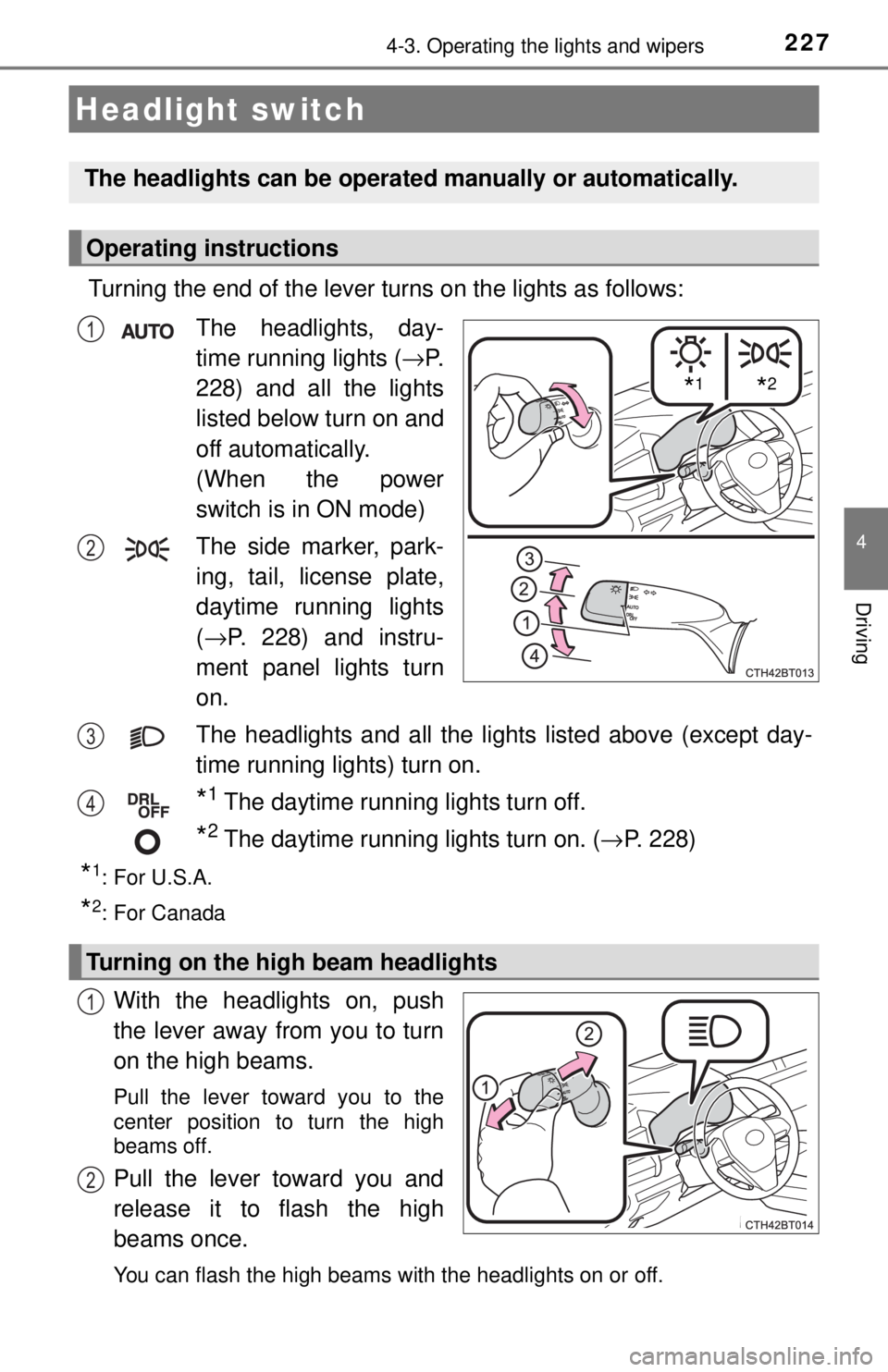
227
4
Driving
4-3. Operating the lights and wipers
Turning the end of the lever turns on the lights as follows:The headlights, day-
time running lights
(→ P.
228) and all the lights
listed below turn on and
off automatically.
(When the power
switch is in ON mode)
The side marker, park-
ing, tail, license plate,
daytime running lights
( → P. 228) and instru-
ment panel lights turn
on.
The headlights and all the lights listed above (except day-
time running lights) turn on.
*1 The daytime running lights turn off.
*2 The daytime running lights turn on. ( → P. 228)
*1:For U.S.A.
*2: For Canada
With the headlights on, push
the lever away from you to turn
on the high beams.
Pull the lever toward you to the
center position to turn the high
beams off.
Pull the lever toward you and
release it to flash the high
beams once.
You can flash the high beams with the headlights on or off.
Headlight switch
The headlights can be operated manually or automatically.
Operating instructions
*1*2
1
2
3
4
Turning on the high beam headlights
1
2
Page 228 of 596
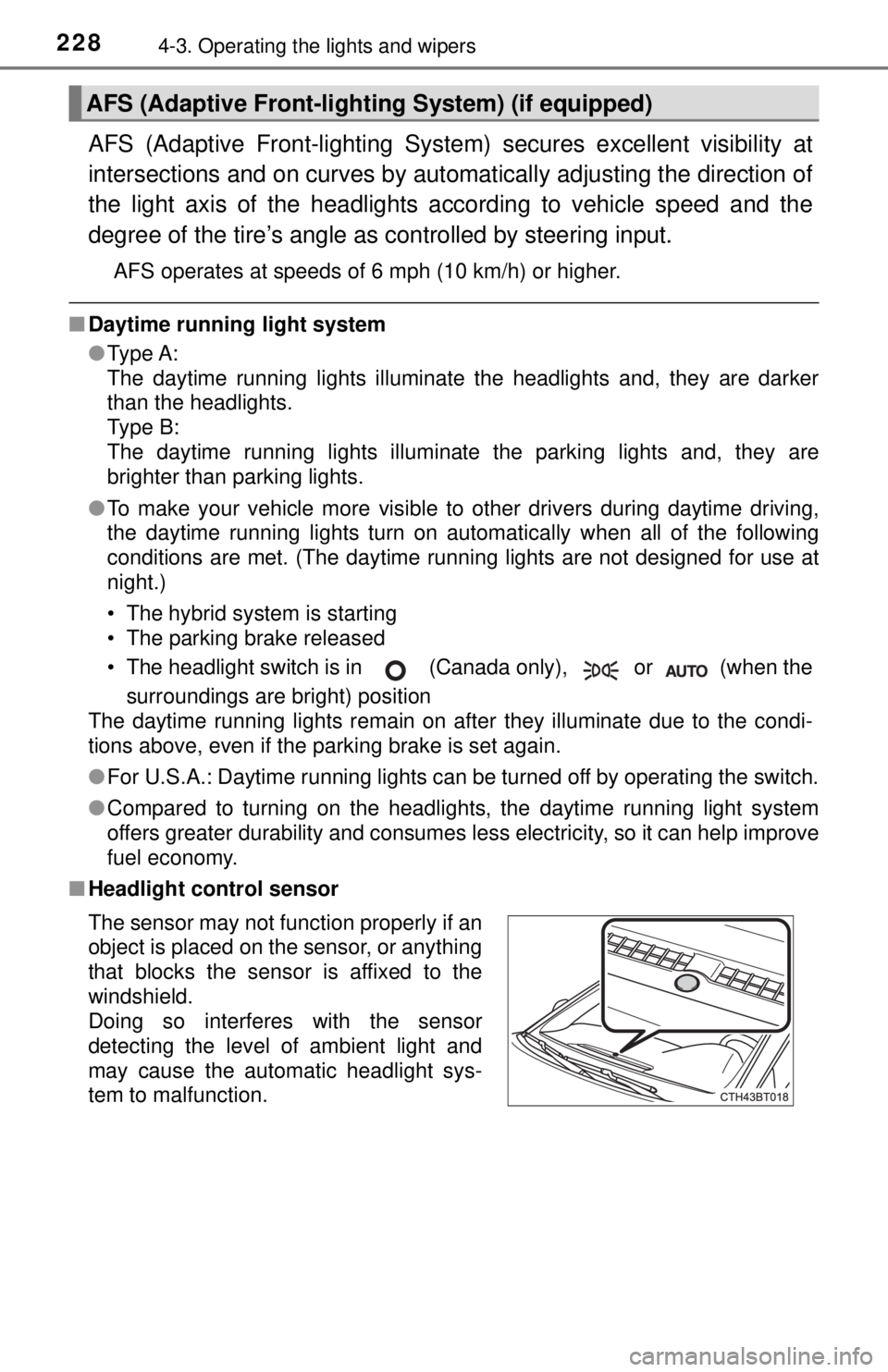
2284-3. Operating the lights and wipers
AFS (Adaptive Front-lighting System) secures excellent visibility at
intersections and on curves by auto matically adjusting the direction of
the light axis of the headlights according to vehicle speed and the
degree of the tire’s angle as controlled by steering input.
AFS operates at speeds of 6 mph (10 km/h) or higher.
■Daytime running light system
●Type A:
The daytime running lights illuminate the headlights and, they are darker
than the headlights.
Type B:
The daytime running lights illuminate the parking lights and, they are
brighter than parking lights.
● To make your vehicle more visible to other drivers during daytime driving,
the daytime running lights turn on automatically when all of the following
conditions are met. (The daytime running lights are not designed for use at
night.)
• The hybrid system is starting
• The parking brake released
• The headlight switch is in (Canada only), or (when the
surroundings are bright) position
The daytime running lights remain on after they illuminate due to the condi-
tions above, even if the parking brake is set again.
● For U.S.A.: Daytime running lights can be turned off by operating the switch.
● Compared to turning on the headlights, the daytime running light system
offers greater durability and consumes less electricity, so it can help improve
fuel economy.
■ Headlight control sensor
AFS (Adaptive Front-lighting System) (if equipped)
The sensor may not function properly if an
object is placed on the sensor, or anything
that blocks the sensor is affixed to the
windshield.
Doing so interferes with the sensor
detecting the level of ambient light and
may cause the automatic headlight sys-
tem to malfunction.
Page 229 of 596
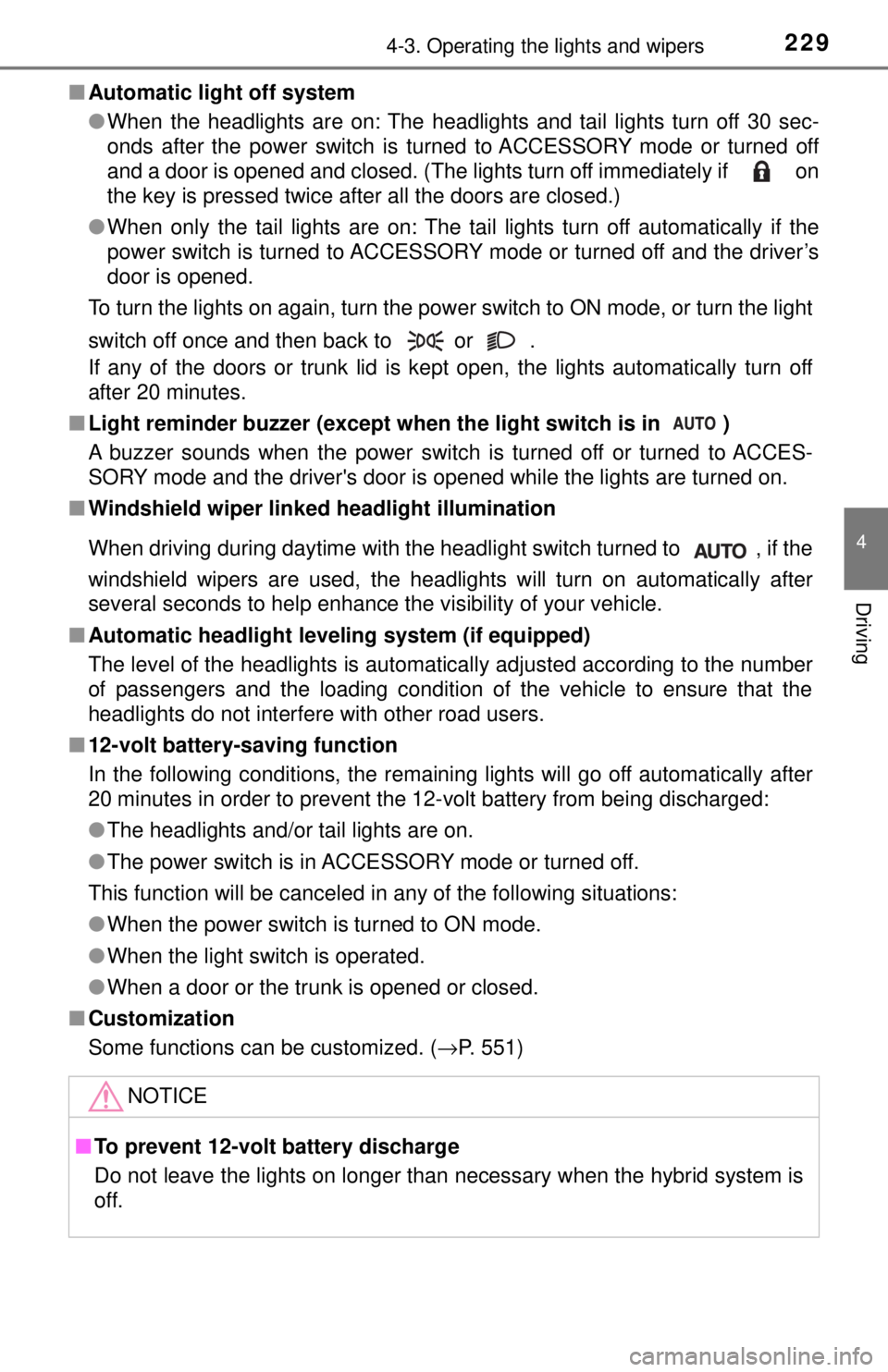
2294-3. Operating the lights and wipers
4
Driving
■Automatic light off system
●When the headlights are on: The headlights and tail lights turn off 30 sec-
onds after the power switch is turned to ACCESSORY mode or turned off
and a door is opened and closed. (The lights turn off immediately if on
the key is pressed twice after all the doors are closed.)
● When only the tail lights are on: The tail lights turn off automatically if the
power switch is turned to ACCESSORY mode or turned off and the driver’s
door is opened.
To turn the lights on again, turn the power switch to ON mode, or turn th\
e light
switch off once and then back to or .
If any of the doors or trunk lid is kept open, the lights automatically turn off
after 20 minutes.
■ Light reminder buzzer (except when the light switch is in )
A buzzer sounds when the power switch is turned off or turned to ACCES-
SORY mode and the driver's door is opened while the lights are turned on.
■ Windshield wiper linked headlight illumination
When driving during daytime with the headlight switch turned to , if the
windshield wipers are used, the headlights will turn on automatically after
several seconds to help enhance the visibility of your vehicle.
■ Automatic headlight leveling system (if equipped)
The level of the headlights is automatically adjusted according to the n\
umber
of passengers and the loading condition of the vehicle to ensure that the
headlights do not interfere with other road users.
■ 12-volt battery-saving function
In the following conditions, the remaining lights will go off automatically after
20 minutes in order to prevent the 12-volt battery from being discharged:
●The headlights and/or tail lights are on.
● The power switch is in ACCESSORY mode or turned off.
This function will be canceled in any of the following situations:
● When the power switch is turned to ON mode.
● When the light switch is operated.
● When a door or the trunk is opened or closed.
■ Customization
Some functions can be customized. ( →P. 551)
NOTICE
■To prevent 12-volt battery discharge
Do not leave the lights on longer than necessary when the hybrid system is
off.
Page 230 of 596
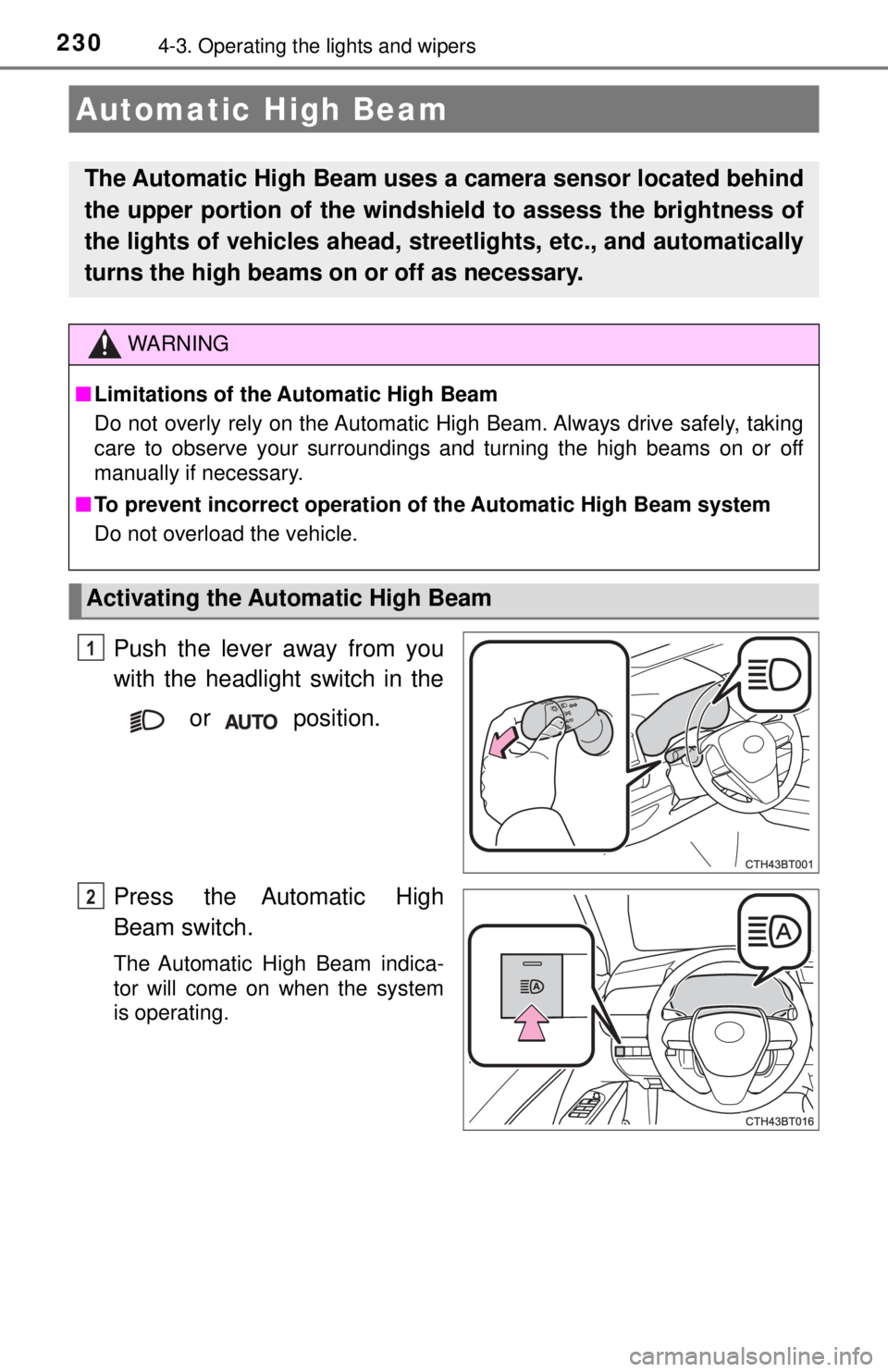
2304-3. Operating the lights and wipers
Push the lever away from you
with the headlight switch in the or position.
Press the Automatic High
Beam switch.
The Automatic High Beam indica-
tor will come on when the system
is operating.
Automatic High Beam
The Automatic High Beam uses a camera sensor located behind
the upper portion of the windshiel d to assess the brightness of
the lights of vehicles ahead, streetlights, etc., and automatically
turns the high beams on or off as necessary.
WARNING
■ Limitations of the Automatic High Beam
Do not overly rely on the Automatic High Beam. Always drive safely, taking
care to observe your surroundings and turning the high beams on or off
manually if necessary.
■ To prevent incorrect operation of the Automatic High Beam system
Do not overload the vehicle.
Activating the Automatic High Beam
1
2
Page 231 of 596
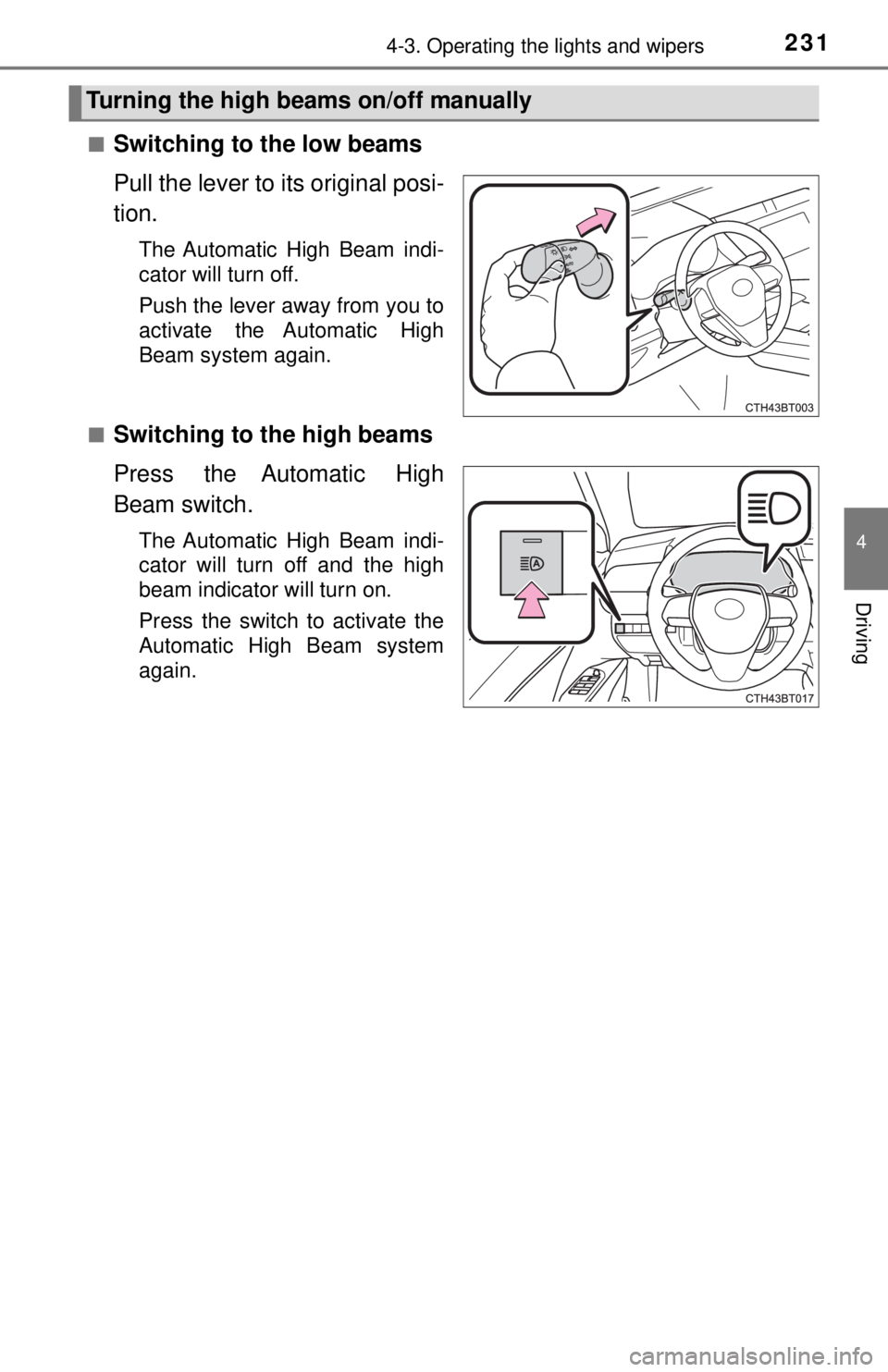
2314-3. Operating the lights and wipers
4
Driving
■Switching to the low beams
Pull the lever to its original posi-
tion.
The Automatic High Beam indi-
cator will turn off.
Push the lever away from you to
activate the Automatic High
Beam system again.
■
Switching to the high beams
Press the Automatic High
Beam switch.
The Automatic High Beam indi-
cator will turn off and the high
beam indicator will turn on.
Press the switch to activate the
Automatic High Beam system
again.
Turning the high beams on/off manually
Page 232 of 596

2324-3. Operating the lights and wipers
■Conditions to turn the high beams on/off automatically
●When all of the following conditions are met, the high beams will be turned
on automatically (after approximately 1 second):
• The vehicle speed is approximately 21 mph (34 km/h) or more.
• The area ahead of the vehicle is dark.
• There are no vehicles ahead with headlights or tail lights turned on.
• There are few streetlights on the road ahead.
● If any of the following conditions is met, the high beams will turn off automat-
ically:
• The vehicle speed is below approximately 17 mph (27 km/h).
• The area ahead of the vehicle is not dark.
• Vehicles ahead have their headlights or tail lights turned on.
• There are many streetlights on the road ahead.
■ Camera sensor detection information
●The high beams may not be automatically turned off in the following situa-
tions:
• When a vehicle suddenly appears from around a curve
• When the vehicle is cut in front of by another vehicle
• When vehicles ahead cannot be detected due to repeated curves, road
dividers or roadside trees
• When vehicles ahead appear in a faraway lane on a wide road
• When the lights of vehicles ahead are not on
● The high beams may be turned off if a vehicle ahead that is using fog lights
without its headlights turned on is detected.
● House lights, street lights, traffic signals, and illuminated billboards or signs
and other reflective objects may cause the high beams to change to the low
beams, or the low beams to remain on.
● The following factors may affect the amount of time taken for the high
beams to turn on or off:
• The brightness of the headlights, fog lights, and tail lights of vehicles
ahead
• The movement and direction of vehicles ahead
• When a vehicle ahead only has operational lights on one side
• When a vehicle ahead is a two-wheeled vehicle
• The condition of the road (gradient, curve, condition of the road surface,
etc.)
• The number of passengers and amount of luggage in the vehicle
● The high beams may turn on or off unexpectedly.
● Bicycles or similar vehicles may not be detected.
Page 233 of 596

2334-3. Operating the lights and wipers
4
Driving
●In the following situations the system may not be able to correctly detect the
surrounding brightness level. This may cause the low beams to remain on
or the high beams to flash or dazzle pedestrians or vehicles ahead. In such
a case, it is necessary to manually switch between the high and low beams.
• When driving in inclement weather (heavy rain, snow, fog, sandstorms,
etc.)
• When the windshield is obscured by fog, mist, ice, dirt, etc.
• When the windshield is cracked or damaged
• When the camera sensor is deformed or dirty
• When the temperature of the camera sensor is extremely high
• When the surrounding brightness level is equal to that of headlights, tai\
l
lights or fog lights
• When headlights or tail lights of vehicles ahead are turned off, dirty, changing color, or not aimed properly
• When the vehicle is hit by water, snow, dust, etc. from a preceding vehi- cle
• When driving through an area of in termittently changing brightness and
darkness
• When frequently and repeatedly driving ascending/descending roads, or roads with rough, bumpy or uneven surfaces (such as stone-paved
roads, gravel roads, etc.)
• When frequently and repeatedly taking curves or driving on a winding road
• When there is a highly reflective object ahead of the vehicle, such as a sign or mirror
• When the back of a preceding vehicle is highly reflective, such as a con-
tainer on a truck
• When the vehicle's headlights are damaged or dirty, or are not aimed properly
• When the vehicle is listing or titling due to a flat tire, a trailer being towed,
etc.
• When the headlights are changed between the high beams and low
beams repeatedly in an abnormal manner
• When the driver believes that the high beams may be flashing or dazzling pedestrians or other drivers
■ Temporarily lowering sensor sensitivity
The sensitivity of the sensor can be temporarily lowered.
Turn the power switch off while the following conditions are met.
• The headlight switch is in .
• The headlight switch lever is in high beam position.
Turn the power switch to the ON mode.
Within 5 seconds after , repeat pulling the headlight switch lever to the
original position then pushing it to the high beam position quickly 9 times,
then leave the lever in high beam position.
Automatic High Beam (headlights) may turn on even when the vehicle is
stopped.
1
2
32